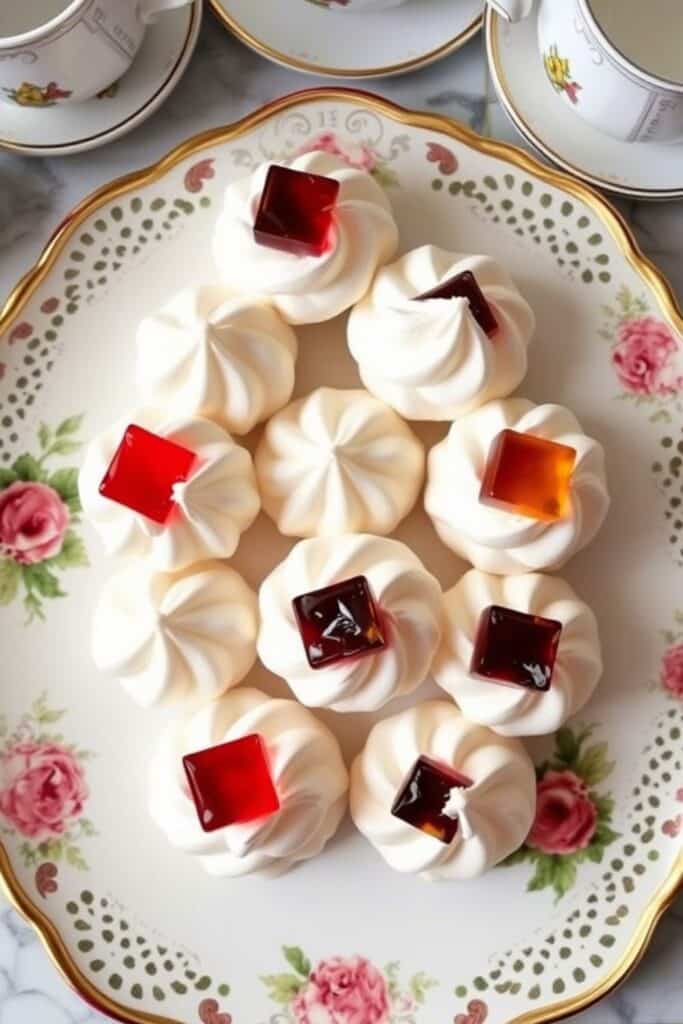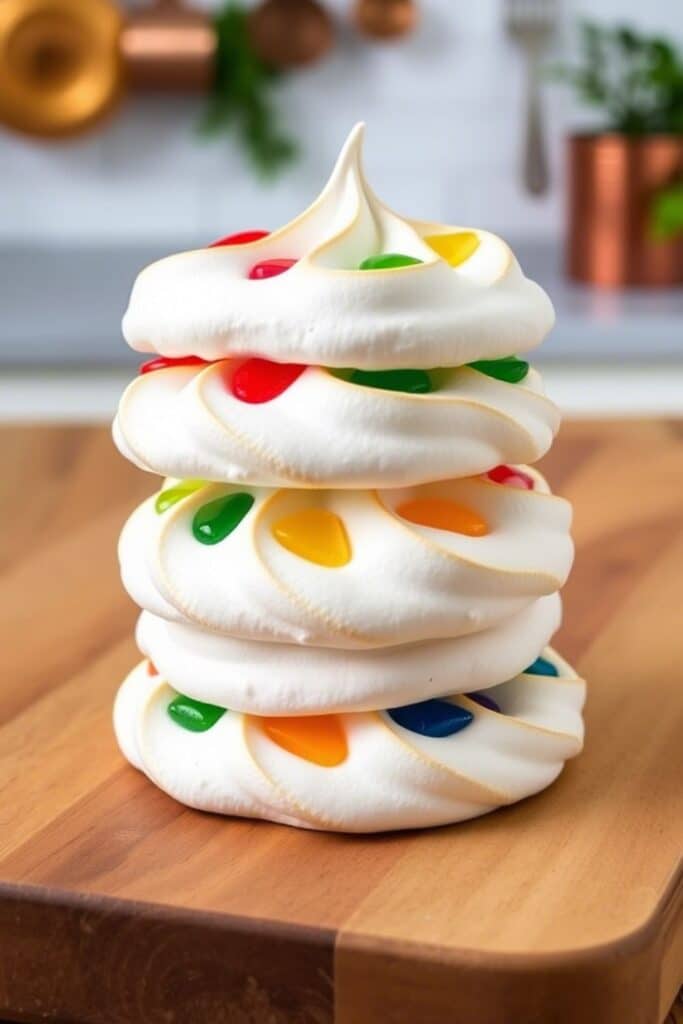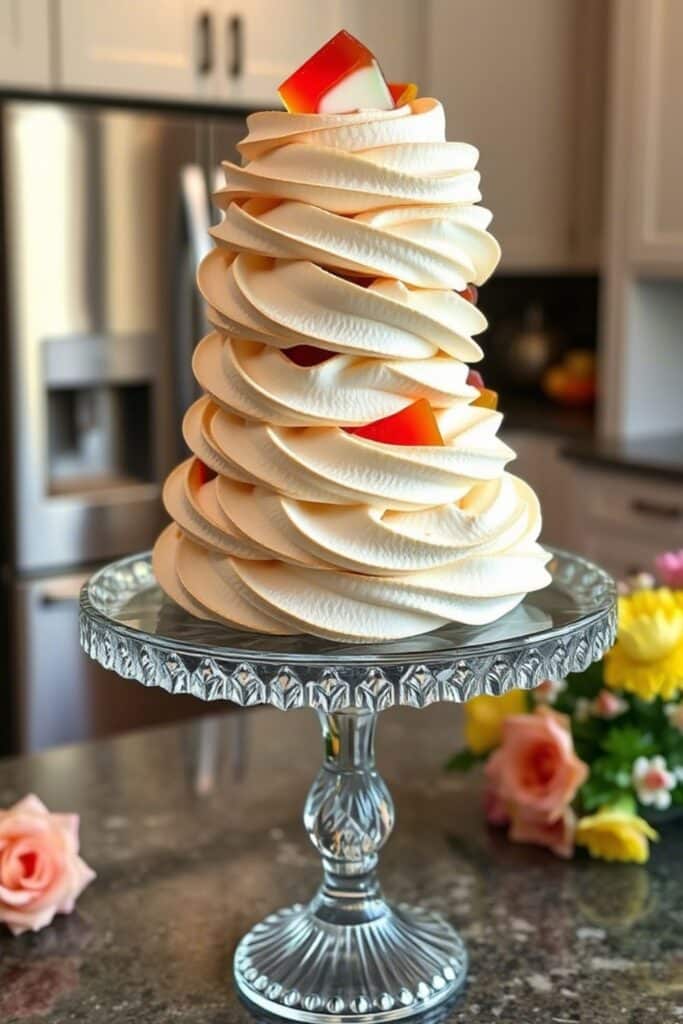Last spring, I was catering a baby shower when disaster struck my planned dessert table collapsed under humid weather conditions. With thirty minutes to spare and a pantry stocked with basics, I grabbed egg whites, sugar, and a forgotten box of strawberry Jello. What emerged from that frantic moment became the most requested recipe in my repertoire.
These aren’t your grandmother’s meringues, nor are they conventional cookies. Jello meringue cookies occupy a delightful middle ground crispy shells that dissolve into ethereal sweetness, bursting with vibrant flavor that makes every bite a small celebration. They’re deceptively simple yet sophisticated enough to grace any dessert table.
The magic lies in how gelatin powder transforms traditional meringue structure. While classic meringues rely solely on sugar for stability, the gelatin creates additional protein networks that enhance both texture and flavor retention. This technique has roots in French patisserie, where chefs have long understood that gelatin amplifies meringue’s natural properties without compromising its delicate nature.
What Makes These Cookies Special
Unlike traditional cookies that rely on flour and fat for structure, jello meringue cookies achieve their form through carefully controlled protein coagulation. The result is a confection that’s simultaneously light as air and intensely flavorful. They’re naturally gluten-free, fat-free, and can be made sugar-free with appropriate substitutions.
The visual appeal is undeniable. These cookies emerge from the oven with jewel-like colors that seem almost too beautiful to eat. Their glossy surfaces catch light like precious gems, while their interior remains pillowy soft with just enough chew to satisfy.
Most importantly, they’re incredibly forgiving. Even novice bakers can achieve professional-looking results because the gelatin provides insurance against common meringue failures like weeping or collapse.
Ingredients & Substitutions

Essential Components
Egg whites (4 large): The foundation of any meringue, egg whites must be completely free of yolk contamination. Room temperature whites whip faster and achieve greater volume than cold ones. For best results, separate eggs while cold, then let whites come to room temperature for 30 minutes before whipping.
Granulated sugar (1 cup): Superfine sugar dissolves more readily than regular granulated sugar, creating smoother meringues. If using regular sugar, pulse it briefly in a food processor to reduce crystal size. Avoid powdered sugar, which contains cornstarch that can interfere with protein networks.
Jello powder (1 package, 3 oz): Any flavor works beautifully, though fruit flavors tend to produce more vibrant results. Sugar-free varieties work equally well for those managing dietary restrictions. The key is using unflavored gelatin powder if you prefer to control sweetness and flavoring independently.
Cream of tartar (1/4 teaspoon): This acidic stabilizer helps proteins coagulate more efficiently and prevents overbeating. If unavailable, substitute with 1/2 teaspoon white vinegar or lemon juice.
Professional Substitutions
For diabetic-friendly versions, replace regular Jello with sugar-free alternatives. The texture remains virtually identical, though colors may appear slightly less vibrant. Natural food coloring can compensate for any color loss.
Egg white powder can substitute for fresh whites in emergency situations. Use 2 tablespoons powder whisked with 6 tablespoons warm water per 4 egg whites. However, fresh whites produce superior texture and stability.
Vegan alternatives exist using aquafaba (chickpea liquid) instead of egg whites. Use 1/2 cup aquafaba plus 1 teaspoon agar powder for similar results, though the texture will be slightly denser.
Step-by-Step Instructions
Preparation Phase
Preheat your oven to 200°F (93°C). Line two baking sheets with parchment paper or silicone mats. Avoid wax paper, which can stick to the meringues during baking.
Ensure all equipment is meticulously clean. Even trace amounts of fat or soap residue can prevent proper whipping. Wipe bowl and beaters with white vinegar, then dry thoroughly.
Creating the Meringue Base
Begin whipping egg whites at medium speed until foamy. This gentle start prevents overbeating later. Add cream of tartar once foam forms it should resemble sea foam with small, uniform bubbles.
Gradually increase speed to medium-high. Continue beating until soft peaks form when beaters are lifted. The peaks should curl over slightly rather than standing straight.
Now comes the crucial step: adding sugar. Incorporate it gradually, one tablespoon at a time, beating well after each addition. This slow incorporation prevents the meringue from becoming gritty or unstable. The mixture should become increasingly glossy and thick.
Incorporating the Jello
Once stiff peaks form, reduce mixer speed to low. Slowly add Jello powder, mixing just until evenly distributed. Overmixing at this stage can deflate the meringue, so work quickly but gently.
The finished mixture should hold its shape when piped yet remain smooth and glossy. If it appears too stiff, the meringue may have been overbeaten. If too loose, continue beating briefly until proper consistency returns.
Shaping and Baking
Transfer mixture to a piping bag fitted with a star tip, or simply use a spoon for rustic shapes. Pipe 2-inch rounds onto prepared baking sheets, leaving space between each cookie as they’ll expand slightly during baking.
Bake for 2-3 hours, rotating pans halfway through. The cookies are done when they lift easily from parchment and sound hollow when tapped gently. They should feel dry to the touch but not browned.
Turn off oven and crack the door slightly. Allow cookies to cool completely in the oven this prevents cracking from sudden temperature changes.
Cooking Techniques & Science

Understanding Meringue Structure
Meringues work through protein denaturation. When egg whites are whipped, mechanical action unfolds protein molecules, which then trap air bubbles. Sugar stabilizes this foam by increasing viscosity and preventing bubble collapse.
The addition of gelatin creates secondary protein networks that further stabilize the structure. This is why jello meringue cookies maintain their shape better than traditional meringues, especially in humid conditions.
Low-temperature baking slowly removes moisture while preserving the delicate foam structure. Higher temperatures would cause rapid moisture loss, leading to cracking or collapse.
Critical Success Factors
Humidity is meringue’s greatest enemy. On humid days, extend baking time or use a dehydrator if available. Properly made meringues should store in airtight containers for up to a week without losing their crisp texture.
Temperature control is equally important. Too high, and the exterior sets before the interior dehydrates. Too low, and the meringues never achieve proper crispness.
The quality of your mixing bowl affects results significantly. Copper bowls produce the most stable meringues due to beneficial chemical reactions between copper and egg proteins. Stainless steel works well, but avoid plastic bowls which can retain traces of fat.
Serving & Pairing Suggestions
Presentation Ideas
Arrange cookies on tiered stands for maximum visual impact. The jewel-like colors create stunning displays that photograph beautifully for social media or special occasions.
Consider creating color gradients by making multiple batches with different Jello flavors. Arrange from light to dark or create rainbow patterns that delight both children and adults.
For elegant plating, serve alongside fresh berries that complement the Jello flavors. Strawberry cookies pair beautifully with fresh strawberries and a dollop of whipped cream.
Complementary Pairings
These cookies shine as palate cleansers between courses. Their light texture and bright flavors refresh the palate without overwhelming subsequent dishes.
Pair with light dessert wines or champagne for sophisticated entertaining. The effervescence echoes the cookies’ airy texture while complementing their sweetness.
For casual gatherings, serve with coffee or tea. The cookies’ intense flavors hold up well against bold beverages, while their light texture prevents overwhelming the palate.
Coffee service becomes more interesting when cookies match the season orange for autumn, lime for summer, or cranberry for winter holidays.
Troubleshooting Common Issues
Preventing Failure
Weeping (moisture beading on surface) typically results from underbaking or high humidity. Ensure cookies are completely dry before storing, and consider using a dehydrator on particularly humid days.
Cracking usually occurs from temperature shock. Always cool cookies gradually in the turned-off oven rather than removing them immediately to room temperature.
Collapse often stems from overbeaten egg whites or contamination with fat. Start over if whites become chunky or separate there’s no salvaging overbeaten meringue.
Storage and Longevity
Store completely cooled cookies in airtight containers with parchment paper between layers. Properly stored, they maintain quality for up to two weeks.
Freeze for longer storage, though texture may become slightly less crisp. Thaw at room temperature without unwrapping to prevent condensation.
Never refrigerate these cookies the humidity will make them soggy within hours.
Creative Variations

Flavor Combinations
Experiment with mixing Jello flavors for unique combinations. Strawberry-lemon creates sophisticated tartness, while orange-vanilla evokes creamsicle memories.
Add extracts sparingly a few drops of almond extract transforms cherry cookies into something reminiscent of maraschino cherries.
Incorporate freeze-dried fruit powder for intense, natural flavors without added moisture that could destabilize the meringue.
Textural Modifications
Fold in chopped nuts or mini chocolate chips just before piping for added interest. Keep additions minimal to avoid weighing down the delicate structure.
Create sandwich cookies by filling two meringues with buttercream or ganache. The contrast between crispy exterior and creamy filling creates textural excitement.
The Science Behind Success
Understanding why these cookies work helps troubleshoot issues and inspire variations. The gelatin acts as both flavoring and structural enhancer, creating more stable foam than traditional meringues can achieve.
This stability makes the cookies more forgiving of environmental conditions while maintaining their characteristic lightness. The result is a confection that combines the best aspects of meringues and flavored cookies.
The low-temperature baking process essentially freeze-dries the foam structure, creating the characteristic crispy shell while preserving the tender interior. This technique has applications beyond cookies understanding it opens doors to other foam-based desserts.
Professional Tips for Perfect Results
Invest in a good digital scale for consistent results. Measuring ingredients by weight rather than volume eliminates variables that can affect outcome.
Keep detailed notes about environmental conditions when baking. Humidity, temperature, and even barometric pressure can affect results, and tracking these factors helps predict necessary adjustments.
Practice piping techniques with plain meringue before attempting decorative shapes. Consistent sizing ensures even baking and professional appearance.
Final Thoughts
These jello meringue cookies represent the beautiful intersection of simplicity and sophistication. They prove that extraordinary results don’t always require complex techniques sometimes the most magical creations emerge from understanding how simple ingredients interact.
The technique translates to countless variations, limited only by available Jello flavors and your imagination. Once you master the basic method, you’ll find yourself creating custom colors and flavors for every occasion.
Most importantly, these cookies bring joy. Their vibrant colors and ethereal texture create smiles that remind us why we fell in love with baking in the first place. In a world of complex techniques and exotic ingredients, sometimes the most profound pleasure comes from transforming the simplest components into something extraordinary.
Whether you’re a professional baker looking to add whimsy to your repertoire or a home cook seeking impressive results with minimal effort, these cookies deliver on every front. They’re proof that great baking isn’t about complexity it’s about understanding your ingredients and treating them with respect.
Frequently Asked Questions?
Q: Can I make these cookies ahead of time for events?
A: Absolutely! These cookies are ideal make-ahead treats. Bake them completely, then store in airtight containers for up to two weeks. They actually improve slightly after a day or two as flavors meld and textures stabilize. For events, I often make them three days ahead they’re still perfect and one less thing to worry about on the day of the event.
Q: What should I do if my meringue won’t hold stiff peaks?
A: This usually happens due to fat contamination or overbeating. First, check that your bowl and beaters are completely clean even a trace of grease can prevent proper whipping. If the whites become grainy or start to separate, they’ve been overbeaten and unfortunately can’t be salvaged. Start over with fresh egg whites, and this time watch carefully for the glossy, stable peak stage.
Q: Why do my cookies sometimes crack during baking?
A: Cracking typically results from temperature shock or baking at too high a temperature. The low 200°F temperature is crucial higher heat causes the outside to set too quickly while the inside is still expanding. Also, always cool cookies gradually in the turned-off oven rather than removing them immediately to room temperature. This prevents the sudden temperature change that causes stress cracks.
Q: Can I use egg white powder instead of fresh egg whites?
A: While fresh egg whites produce superior results, egg white powder works in a pinch. Use 2 tablespoons powder whisked with 6 tablespoons warm water to replace 4 fresh egg whites. However, expect slightly less volume and stability. The texture will be acceptable but not quite as ethereal as with fresh whites.
Q: How do I prevent my cookies from becoming sticky or weeping?
A: Stickiness and weeping are moisture problems. Ensure cookies are completely baked they should sound hollow when tapped and lift easily from parchment. On humid days, extend baking time slightly or use a dehydrator. Once cooled, store immediately in airtight containers with parchment paper between layers. Never refrigerate these cookies, as the humidity will make them soggy within hours.

Veronica is a passionate food enthusiast with over three years of experience in exploring and writing about diverse cuisines. Her expertise lies in reviewing restaurants, sharing creative recipes, and discovering the latest food trends. As the voice behind FoodieRecap.com, Anju brings fresh perspectives and culinary insights to her audience.
